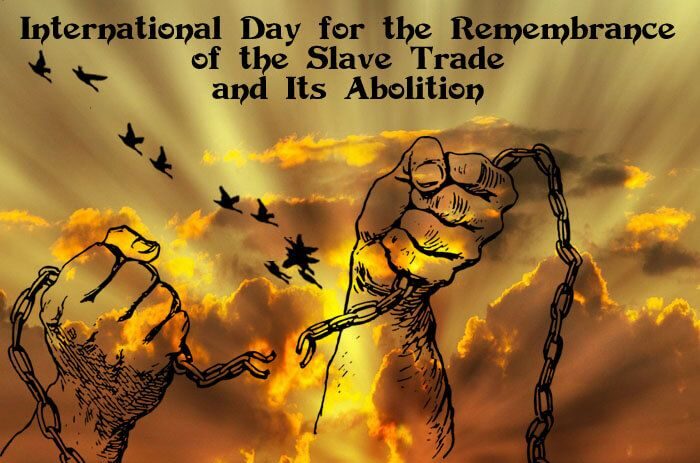International Day for the Remembrance of the Slave Trade and Its Abolition: Honoring History and Advocating for Equality
Introduction: International Day for the Remembrance of the Slave Trade
Every year on August 23, the world observes the International Day for the Remembrance of the Slave Trade and Its Abolition. This day serves as a solemn reminder of the horrific history of the transatlantic slave trade, which spanned from the 16th to the 19th century, and the ongoing struggle for racial justice. It marks the abolition of the transatlantic slave trade and highlights the resilience and resistance of enslaved people. The day is an opportunity to reflect on the past, raise awareness about the lasting impacts of slavery, and work toward creating a future of equality, justice, and peace.
History of the International Day for the Remembrance of the Slave Trade and Its Abolition
The International Day for the Remembrance of the Slave Trade and Its Abolition was established by UNESCO (the United Nations Educational, Scientific, and Cultural Organization) in 1997. It commemorates the night of August 22 to August 23, 1791, when enslaved Africans in Saint-Domingue (present-day Haiti) launched a revolution against French colonial rule, leading to the eventual abolition of the transatlantic slave trade and the formation of the first independent black republic.
This day serves as a reminder not only of the brutality and exploitation of the millions of Africans who were forced into slavery but also of the resistance movements that led to the eventual end of this trade. It acknowledges the contributions of those who fought for freedom and highlights the struggles for equality and justice that continue to this day.
Key Facts About International Day for the Remembrance of the Slave Trade
- Millions Enslaved: The transatlantic slave trade forcibly transported more than 12 million African people to the Americas over several centuries. They were treated as property, subjected to inhumane conditions, and deprived of their basic human rights.
- Resistance and Rebellion: Enslaved individuals across the Americas engaged in acts of resistance, including rebellion, sabotage, and escape, contributing to the eventual abolition of the trade. The Haitian Revolution, led by figures like Toussaint Louverture, is a key example of enslaved people rising up against their oppressors.
- Abolition Movements: The abolition of the transatlantic slave trade was a gradual process, driven by both external and internal pressures. In Britain, the Slave Trade Act of 1807 made it illegal to engage in the slave trade, while in the United States, the Slave Trade Act of 1808 did the same. The final abolition of slavery across many nations came later in the 19th century.
- The Legacy of Slavery: Despite the abolition of the slave trade, the effects of slavery continue to reverberate today. The systemic racism, economic disparities, and social injustices that were built upon the foundation of slavery still persist in many parts of the world.
- UNESCO’s Role: UNESCO plays a critical role in promoting education about the history of slavery, its impacts, and the continuing fight against racism. Through various initiatives, UNESCO seeks to preserve the memory of the slave trade and its abolition while fostering dialogue on the importance of human rights and dignity.
Significance of the International Day for the Remembrance of the Slave Trade and Its Abolition
- Honoring the Lives Lost: This day honors the millions of men, women, and children who suffered under the horrors of slavery. It recognizes their immense suffering and the indomitable spirit of those who resisted their enslavement.
- Educating Future Generations: One of the primary goals of the day is to educate people about the history of the slave trade. By raising awareness, it fosters understanding and encourages societies to confront the past and work toward a more just and inclusive future.
- Raising Awareness of Modern Slavery: While the transatlantic slave trade is over, modern slavery still exists in various forms today, including human trafficking, forced labor, and exploitation. The International Day for the Remembrance of the Slave Trade and Its Abolition also serves as a call to action to combat contemporary forms of slavery.
- Acknowledging Resistance Movements: The day highlights the courage and resilience of those who fought against slavery, whether through rebellion, legal challenges, or activism. It honors the contributions of abolitionists and advocates for racial equality who worked tirelessly to end the slave trade.
- Promoting Racial Equality: The day serves as an important reminder of the ongoing struggle for racial justice. It calls attention to the systemic inequalities that persist and emphasizes the importance of continuing the fight for equality and human rights.
How to Observe the International Day for the Remembrance of the Slave Trade and Its Abolition
- Educate Yourself and Others: Take the time to learn more about the history of the slave trade and its abolition. Read books, watch documentaries, or attend educational events. Share this knowledge with others to foster greater awareness and understanding.
- Support Anti-Slavery Organizations: Many organizations are working to combat modern-day slavery and human trafficking. Donating time or resources to these causes can help continue the fight against exploitation and injustice.
- Attend or Organize Commemorative Events: Many communities hold events on this day, such as memorial services, lectures, and exhibitions, to commemorate the history of the slave trade and its abolition. These events offer an opportunity to reflect, learn, and discuss the ongoing impact of slavery.
- Reflect and Advocate for Justice: Use the day to reflect on how far society has come in terms of human rights and racial equality. However, also think about what remains to be done. Advocate for policy changes that promote racial justice and support efforts to address economic and social disparities rooted in slavery.
- Support Racial and Social Justice Movements: Join or support organizations working to end systemic racism and promote equality for marginalized communities. Whether through donations, volunteering, or amplifying the voices of advocates, your efforts can contribute to positive change.
FAQs about the International Day for the Remembrance of the Slave Trade and Its Abolition
1. Why is the International Day for the Remembrance of the Slave Trade and Its Abolition important?
It serves as a reminder of the history of slavery, honors the lives lost, and encourages continued efforts for racial equality, social justice, and the abolition of modern-day slavery.
2. How can I participate in the observance of this day?
You can participate by learning more about the history of the slave trade, supporting anti-slavery organizations, attending events, and advocating for social and racial justice.
3. What is the legacy of the transatlantic slave trade?
The legacy of the transatlantic slave trade includes the continued economic, social, and political disadvantages faced by descendants of enslaved people, as well as the persistence of racism and inequality.
4. How does this day address modern-day slavery?
This day not only honors the history of slavery but also raises awareness of ongoing issues like human trafficking, forced labor, and exploitation, calling for action to eradicate modern slavery.
Conclusion: International Day for the Remembrance of the Slave Trade
The International Day for the Remembrance of the Slave Trade and Its Abolition is more than just a day of remembrance; it is a call to action. By educating ourselves and others about the horrors of the past and their lasting impacts, we can contribute to a future where human dignity, equality, and justice prevail. On this day, we honor the resilience and courage of those who fought for freedom and continue to advocate for a world where the legacy of slavery is finally overcome.










